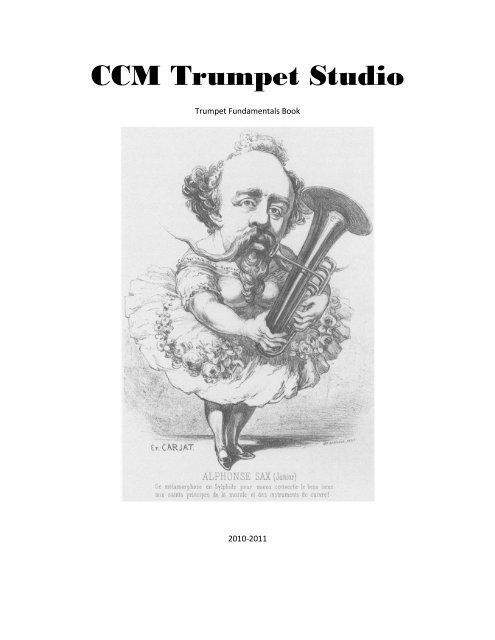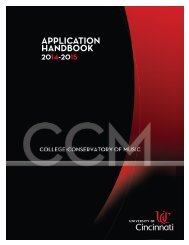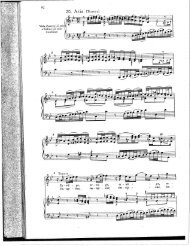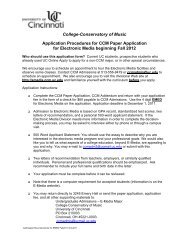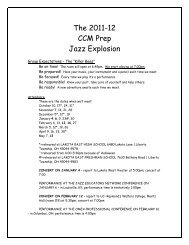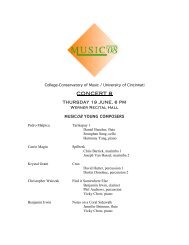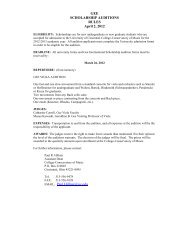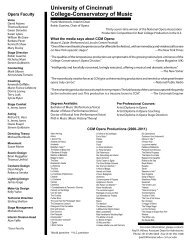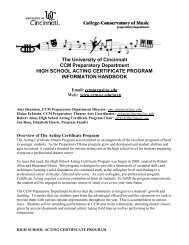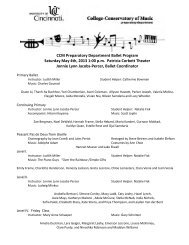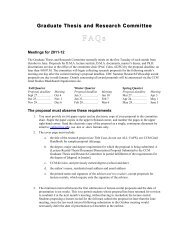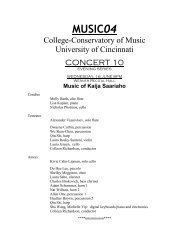Download Ccm Trumpet Studio
Download Ccm Trumpet Studio
Download Ccm Trumpet Studio
Create successful ePaper yourself
Turn your PDF publications into a flip-book with our unique Google optimized e-Paper software.
CCM <strong>Trumpet</strong> <strong>Studio</strong><br />
<strong>Trumpet</strong> Fundamentals Book<br />
2010-2011
Table of Contents<br />
Foreword 1<br />
Daily Practice Routine 2<br />
Preparatory Embouchure Studies (Walter Smith) 7<br />
Cichowicz Expansion Slurs 10<br />
Flow and Expansion Studies (James Stamp) 17<br />
Articulation Studies (Chris Gekker) 20<br />
Pitch Bending Exercises (James Stamp) 23<br />
30 Expansion Studies (Harry Glantz) 24<br />
Interval Studies (Jean-Baptiste Arban) 28<br />
Singing/Fingering Patterns (John Schlabach) 30<br />
Technical Studies - Three Day Rotation (Herbert L. Clarke) 32
Foreword<br />
The following daily routine is a resource which will gUide the player through a<br />
structured regimen of studies which is designed to prepare the player for a full day of<br />
playing, as well as continuously hone and improve fundamental skills. Avoid trying to<br />
play everything contained in this volume every day. In fact for moststudents, it will<br />
take some time to learn most of the studies contained within this collection. Strive at<br />
all times to produce the best possible sound. Each study should be worked with a<br />
metronome at all times. Turn the metronome on when entering the practice room, and<br />
leave it on until leaving. set the metronome to a tempo at which each study may be<br />
played with the fewest errors possible, even if that means the quarter note =40 or<br />
slower. Please note the following goals for performance.<br />
Goals for Performance<br />
• Good / Characteristic Tone Quality<br />
• Clean Attack / Note Starts<br />
o Avoid Wah-Wah's<br />
• Smooth Slurs<br />
• Move from center of pitch to center of pitch<br />
o Avoid any extra sound between the notes caused by valve issues or<br />
the lips moving at a different time than the fingers. (Think of the<br />
piano)<br />
• Strive for a homogenous tone in all registers<br />
• Good Intonation<br />
• Play exactly the right note at exactly the right time.<br />
1
Daily Practice Routine<br />
Part 1- Warm up off the trumpet (3-5 mln.)<br />
1. Stretching<br />
Take a few seconds to stretch armsand upper body to limberup and wake<br />
up.Thls should rea simplestretch that is accomplished within about a minute.<br />
2. Breathing Exercises<br />
Use a piece of paper, breathing tube the Breathing Gym, Stamp exercises, etc. Breathing<br />
exercises are most effective when they are simple, natural and directlyrelated to a musical<br />
context. If the inhale is relaxed, naturaland with musical intent, the result be a relaxed sound,<br />
with musical expression. Breathing is fundamental, but breathing without musical thought or<br />
content is simplyan exercise.<br />
3. Loose Lip Warm-up<br />
loosens up the muscles, increases blood-flow, warms up all ranges<br />
4. Free Buzz<br />
Numbers 2-4 should happen quite fast and serve as a warm-up and reminder beforeapplying the<br />
instrument. A few minutes in the beginning of Stamp will suffice.<br />
5. Ear Training - Schlabach Studies (Ohio University <strong>Trumpet</strong> <strong>Studio</strong> Patterns)<br />
Spend a few minutes at the piano with these studies. Doing this early will help honethe player's<br />
ear before continuing to more advanced studies.<br />
Part 2 - Warm up on the trumpet<br />
Remember that even though this section is a "warm up," the player should constantly strive for<br />
the best possible sound and to achieve the fundamental goals.<br />
1. Mouthpiece work (five note scales/Stamp)<br />
Takea minuteon the mouthpiece to do check pitch and properair flow. Strive for a good<br />
mouthpiece sound and intonation at all times. It may be a good ideal to play thesestudies while<br />
seated at the piano in order to check the notesoften.<br />
2. Flow studies (Stamp 3, 4a, 4b, 5/Cichowicz flow)<br />
Use these to enhance tone, smoothness of slursand overall ease of performance. You must<br />
develop an ear for this easy style of performance. Demand of yourselfa beautiful sound at all<br />
times.<br />
3. Slow simple slurs (Schlossberg 1-20, Irons group 1-12,etc.)<br />
Read Irons notes. Slow practice at a variety of dynamics and ALWAYS with the metronome is<br />
critical. DoshorterIrons 3X, 4X.<br />
2
Part 3 Maintenance<br />
STILL WITH THE METRONOME and TUNER<br />
1. Scales and Arpeggios -<br />
Workout a three day rotation, so you cover all scales twice a week<br />
Major (by step and by third)<br />
Minor - Natural; Harmonic; Merodic<br />
Whole Tone<br />
Pentatonic<br />
Arpeggios - major, minor, diminished, augmented. You can use patterns by<br />
Arban, MacGregor, Pares, etc.<br />
2. Articulation<br />
These articulation pattern exercises, used for years at Eastman, are a greatway<br />
to strive for excellence through simplicity.<br />
Articulation Study<br />
Always play extremely tenuto using the vocalsyllable "du"or "de" - totally connected<br />
1. ppp with appropriate emotion and your best sound<br />
2. flfwith appropriate emotion and best sound - don't go flat<br />
3. each day, perform several in all ranges, keys, and dynamics<br />
333 3<br />
Afterfirst 2 sustained measures, extreme staccato without changing the airsupport, tone, or<br />
going flat Playas ifusing the vocalsyllable "teb."<br />
1. pppwith appropriate emotion and your best sound<br />
2. flfwith appropriate emotion and best sound - don't go flat<br />
3. each day, perform several in all ranges, keys, and dynamics<br />
For DTand IT work, Clarke and Arban are very useful. Try creating exercises to<br />
suit your own needs. Multiple tongue every day.<br />
1. use all dynamic ranges<br />
2. use extreme upper and lower reqlsters,<br />
(Articulation, continued)<br />
3
6. Multiple Tonguing<br />
Before delving into a "multiple tongue study, try working away from the trumpet<br />
with wind patterns. Strive for evenness of rhythm, and strong air on all<br />
syllables. Focus on the fundamentals of the multiple tongue, namely making the<br />
"K" sound like a "T' C'Ga" sound like a "Da''). Pick one note and, at a slow<br />
tempo, work to play both kinds of attacks and get them to sound the same. For<br />
example:<br />
Quarter note =60<br />
TRest TRest K Rest K Rest etc.<br />
TRest K Rest TRest K Rest etc.<br />
K Rest K Rest K Rest K Rest etc.<br />
Alternating the "T's" and "K's" in this fashion at a slow tempo will allow the<br />
player to listen and check to see if both articulations are sounding the same.<br />
After achieving some uniformity in articulation, the player should move to some<br />
advanced studies in:<br />
Scales<br />
Arban<br />
Clarke nos. 2 for double tongue and 7 for triple tongue<br />
Gekker<br />
7. Lyrical Studies<br />
The goal in working any lyrical study is to play it as it would be sung by a great<br />
singer. Use singers as models to emulate in your practice.<br />
Arban, The Art of the Phrasing<br />
Concone - various versions, including LyricalStudies - Concone/Sawyer (Brass<br />
Press, Complete Solfeggio - Concone/Korak (Balquidder) and Concone vocal<br />
editions.<br />
8. Power/Range Slow, steady work is essential. Excess tension is your enemy<br />
Below is a simple exercise attributed to Phil Smith. Make sure you practice this<br />
exercise with the metronome and tuner!!<br />
Philip Smith<br />
" Transpose upwards Y2 step at a time<br />
p =.tr<br />
5
Everyday, cover the following:<br />
Everyday thoughts<br />
- Extremes of dynamics<br />
- Extremes of registers<br />
- Lip slurs and lip trills<br />
- Beauty of sound<br />
- Power of sound<br />
- Single tongue - fast<br />
- Multiple tongue - slow and fast<br />
- Slow (breath control) and fast tempi (almost out of control)<br />
- Sight Reading (duets with a buddy?)<br />
- Transposition<br />
- Initial soft attacks<br />
- Initial hard attacks<br />
- Ornaments (trills, turns, mordents, etc.) Arban pg. 100 - good place to start<br />
- Othertrumpets (e, E-flat, piccolo)<br />
- Lyrical work<br />
- Technical<br />
- Intonation (tuner on?)<br />
Some questions to ask about your Daily Routine<br />
- Is my sound fully open and resonant?<br />
- Are the lips responding easily?<br />
- Are my highs and lows freely working?<br />
- Are all aspects of articulation clear centered and with ease of execution?<br />
6
Cichowicz Expansion Slurs<br />
series 1<br />
10
29<br />
37<br />
46<br />
Cichowicz Expansion Slurs<br />
I series 4<br />
rJ= 50 Vincent Cichowicz<br />
13<br />
--0<br />
t:\<br />
e<br />
t:\<br />
e<br />
t:\<br />
e<br />
n
Intervals<br />
Practice slurred and tongued in each key<br />
28<br />
J.D. Arban
Intervals<br />
29
Ohio University <strong>Trumpet</strong> <strong>Studio</strong> - John Schlabach<br />
Singing/Fingering Patterns<br />
Sing these scale degree patterns as assigned during lessons. Use the syllable "la" (or<br />
solfege) while fingering correctly in both major and minor. Start with easier keys, but<br />
progress as soon as possible to all keys for each pattern. These exercises will develop<br />
your ear and "connect" it to the trumpet, so that it will actively control your playing more<br />
quickly. It is critical to practice these daily both in your trumpet practice session, and<br />
separately. Use pitch reference ifnecessary, but don't play them on the trumpet. Part of<br />
your applied trumpet grade will depend upon your improvement on these patterns.<br />
1st set: Ascending and Descending. The arrows indicate up or down direction for the next<br />
interval. The 7 th scale degree often goes underneath tonic.<br />
1. 1 2 3 4 5 3 4 2 1<br />
2. 1 2 3 5 4 6 5 3 1<br />
3. 1 2 3 4 5 6 4 5 3 2 1 (!)7 1<br />
4. 1 2 3 5 4 3 2 (!)7 1<br />
5. 1 2 3 4 5 6 4 5 3 2 7 2 1<br />
6. 1 3 2 4 3 5 4 2 3 1 2 7 1<br />
7. 123 4 5 6 5 435 4 2 1<br />
8. 12345678978654231<br />
9. 1 2 3 5 6 4 5 7 8 5 4 2 1<br />
10. 1 2 3 4 5 6 7 8 9 7 8 6 5 4 (!)7 2 1<br />
11. 123 5 6 5 9 8 642 1<br />
12. 1 3 2 4 3 5 7 9 8 5 4 2 1<br />
13. 1 3 2 4 3 5 7 9 8 5 4 2 1<br />
14. 1 2 3 5 4 7 9 7 8 6 4 2 1<br />
15. 1 2 3 4 5 6 7 8 9 7 8 4 3 (!)7 1<br />
16. 1 3 2 4 5 3 4 7 8 9 7 8 6 4 (!)7 2 1<br />
17. 1 3 6 5 4 7 9 10 8 5 2 3 1<br />
18. 3 1 2 4 5 3 4 6 7 8 6 4 2 7 1<br />
19. 3 1 2 4 5 3 4 7 8 6 4 7 1<br />
20. 5 3 1 5 6 4 2 (j)7 8 3 4 5 1<br />
21. 1 3 5 3 4 7 9 7 8 #4 5 3 1<br />
22. 3 4 2 7 5 6 4 2 7 8 2 3 1<br />
23. 5 3 2 4 9 5 7 8 3 5 4 2 1<br />
24. 1 6 5 9 8 4 (!)7 2 1<br />
25. 1 (j)7 8 2 3 9 7 (!)7 8<br />
30
2 nd set: Descending patterns (up or down arrows indicate ascending or descending<br />
interval for the next scale degree)<br />
1. 8 7 6 4 5 3 4 2 1<br />
2. 8 7 6 5 3 4 5 2 1<br />
3. 8 5 4 5 3 5 4 2 1<br />
4. 8 67 5 4 3 (!)7 2 1<br />
5. 8 6 5 3 2 4 5 7 1<br />
6. 8 7 6 9 7 6 5 3 4 5 2 3 1<br />
7. 857 4 3 542 1 372 1<br />
8. 8 7 9 8 5 4 3 5 6 4 2 7 1<br />
9. 8 6 4 3 (i)7 5 2 (!)7 1<br />
10. 8 7 6 5 7 6 5 3 4 6 (!)7 5 1<br />
11. 857 4 6 3 5 2 4 (!)7 1 2 1<br />
12. 8 4 6 2 (i)7 3 5 (!)7 1<br />
13. 8 5 9 4 (i)7 3 (!)7 3 1<br />
14. 8 3 6 2 (i)7 4 3 5 1<br />
15. 823 (i)7 5 (!)7 2 4 3<br />
31
Seventh Study<br />
42
-<br />
Fourth Study<br />
46
Seventh Study<br />
48
------<br />
49


